When Tim Arpin and James Henning say they live outdoors, they truly mean it. When warm weather arrives, they derive great pleasure from tending to their gardens and entertaining friends and family in the great outdoors.
Enter the lush backyard and you immediately hear the sound of music, not to mention splashing water and birds. According to Tim, the only time music is not playing is in the dead of night. “I think the plants enjoy it,” he says.
That might qualify as an understatement. Tim’s tropical oasis resembles something you might see in Florida as opposed to South Central Pennsylvania. “I love tropicals and have always been interested in them,” Tim continues. He traces his infatuation to the fact that tropicals are “bold, colorful, dramatic and heat-loving.” And, he loves to push the limits on “wanting what you can’t have.” As a result, the backyard is abloom with plants that arrive from Florida each spring. “I work with a broker down there,” Tim reports. Fortunately, Tim and James have greenhouses on the property that allow them to over-winter many of their plants. “But, clients get priority,” Tim says of his B&B for plants that are susceptible to cold weather.
However, before the tropicals arrive, the garden’s spring palette is more in keeping with Lancaster County thanks to the 10,000 bulbs that burst into bloom as March fades into April.
Tim, who is a graduate of Chicago’s DuPage Horticultural School, moved from his native Kansas in 1987 to work for Witmer’s Greenhouses. In 1989, he launched The Gilded Lily, a multifaceted company dedicated to all things horticultural and decorating. Wanting to put down roots, he bought a property near Columbia in January 1993. “I’ve lived here longer than anywhere,” he notes.
Greenhouses were built on the property in 1993 and 1994. As neighboring properties became available, Tim would buy them in order to expand his gardens and his business. In 1999, he added a warehouse, and in 2005, he expanded by adding another greenhouse as well as a second warehouse.
The backyard has undergone its own metamorphosis. When Tim bought the property (the house dates to the mid-‘70s), flower beds were nonexistent. “There were a lot of trees, though,” he recalls. Tim began the makeover by planting living privacy screens around the perimeter of the backyard. The deck off the kitchen area nearly doubled in size to 12×16 feet. Over the years, extensive, multi-level decking was added in order to create spaces dedicated to dining, relaxing and entertaining. Ponds were added. Houses for the resident peacocks and chickens were built. “We had ducks, too,” Tim adds. Lights illuminate the trees and walkways. Tim’s renowned container gardens abound. “I get started on them in mid-March,” he explains, noting that February’s mild weather prompted him to visit suppliers earlier than usual this year.
Tim and James point out that the gardens not only benefit from TLC, but also from a lot of work. “We rototill the beds several times in the spring,” Tim says. “We’re constantly amending the soil, weeding and mulching,” James adds.
A Medley of Vegetables
The vegetable garden is James’ domain. You name it, and he probably grows it. James, who hails from the northeast area of Pennsylvania, grew up on a dairy farm. “I didn’t expect to ever come back to it,” he says of farming. But, once a farmer, always a farmer seems a fitting motto for him. “I like to forage, too,” he says, naming garlic mustard as one of his favorite finds.
Prior to James taking over the vegetable garden, Tim experimented with vegetables, often incorporating plants into available niches in his flower beds. The purchase of a neighboring property enabled Tim and James to carve out space for a garden that’s totally devoted to growing vegetables and herbs. James, however, has literally taken growing vegetables to new heights by building trellises out of bamboo (on which tomatoes grow) and repurposing hoop houses (over which beans and other vine-type plants meander). “Up is gained space,” he explains. “By going up, you can maximize your space.” Indeed, it’s true here, as the garden seems to go on and on. But, as Tim and James point out, what seems to be a huge expanse is just an optical illusion.
Tomatoes are a specialty of the house. Last year, James experimented with 15 kinds of tomatoes (nearly 100 plants), some of which he had successfully grown in the past and some that were new to him. “Most of them are heirlooms,” he says of the old-fashioned varieties that not only deliver unrivaled taste sensations, but also bear engaging names such as “Mortgage Lifter” and “Nebraska Wedding” (also known as the “Love Apple”). Additionally, he has been experimenting with grafted varieties such as “Orange Icicle”. He’s also fascinated by a variety called “Indigo Rose”, reporting it “actually turns deep purple when it’s hot and sunny.” Each variety is accompanied by signage that, according to James, “aids in record-keeping” and contains pertinent information regarding size, color, taste and uses. The tomatoes are fully utilized during the growing season as they provide the makings for sun-dried tomatoes, marinara and tomato sauce.
Herbs are another mainstay of the garden. “I’ve been a vegetarian for 20 years,” James explains, noting that herbs can enliven even the simplest of dishes. “I’m a firm believer in cooking with herbs.” In his opinion, the fresher they are the better.
James relies on raised beds to grow vegetables such as onions, cucumbers, peppers, sorrel, eggplant, squash, kale, greens, potatoes and more. “We eat from the garden May through December,” he reports. The never-ending bounty is achieved through succession gardening, whereby plants are sown at timed intervals in order to ensure something is always growing or ready for harvest.
Recycling also plays a role in the garden. Most obvious are the boxes that are delivered to The Gilded Lily. Their cardboard is used to line the pathways, while the wood straw that filled them is used to cover the cardboard and serve as mulch. According to James, the methodology controls the weeds with ease.
This area of the property is also home to James and Tim’s 13 chickens. “They all have names,” Tim notes. When the flock had fewer members, they had free range of the backyard. “All that scratching is really destructive,” Tim says of the damage chickens can pose to lawns. Now, they have their own fenced-in yard beside the vegetable garden, which allows them to serve as natural pest control, as they snack on bugs that prey on the plants. Breeds include Araucana (blue eggs), Barred Rock (light brown eggs), Australorp (brown eggs) and Buff Orpingtons (pale brown eggs). “We eat a lot of eggs and give a lot of them away,” Tim reports.
Dinner In and From the Garden
MENU
Passed Hors d’oeuvres
Cucumber Tea Sandwiches
Baba Ganoush
Basil Pesto with Focaccia
Deviled Eggs
Stuffed Calabrese Peppers with Vegetable Sofrito
Served Dinner
Cucumber Soup
Heirloom Tomato Salad
Hawaiian Tuna Loin
Chinese Marinated Eggplant
Dessert
Grilled Stone Fruit
Two years ago, Tim was a member of the Holiday and Major Event Committee at the Hamilton Club. The members of the select committee formed a comradery and became close friends. They began to meet privately as a dinner club for themed signature events. The club is best known as “The Rascals.”
The rules are simple: Each member must host a dinner at least once a year. The host(s) is free to choose the theme and location. The first such dinner was held in December 2015 and had a holiday theme. Since then, themes have included South Beach Chic, Dr. Seuss’s Birthday, Mardi Gras, Denim & Diamonds, Margaritaville Pool Party and the list goes on.
Last August, it was James and Tim’s turn to host their second dinner. For them, the theme was a no-brainer: Farm to Table. “We were determined to grow as much as we could for the dinner,” Tim explains. Supplemental ingredients could be purchased from neighboring farm stands.
While James and Tim planned to prepare the soup course (cucumber), they turned to Chef Rafe Hottenstein of The Greenfield Restaurant for the balance of the menu that would feature produce from their garden. Rafe, who champions locally grown products in his restaurant, was fully onboard and set to work designing a menu for the 14 members and their guests. On the night of the party, Rafe and his staff set up shop in a portion of one of the warehouses that does double duty as a catering kitchen. “We do a fair amount of entertaining, so it comes in handy,” Tim explains.
With a theme in place, Tim and James then designed the look of the party. Home-grown extended to floral design. Sunflowers, which Tim grew, abounded and were used in a variety of ways. Arrangements were composed of other floral finds from the garden. James continued the home-grown theme by designing a cucumber-based signature cocktail.
Where to locate the dining table was an issue. The decks couldn’t accommodate one large table, and the slope of the backyard was equally problematic. Rod Shumaker of Shumaker PDT suggested using a stage to offset the slope of the yard. Dilemma solved! “And, I wanted chandeliers, but nothing too elaborate,” Tim says. Rod took a minimalistic approach by taking strings of Edison-style lights and bunching them. “It was perfect,” Tim says.
The tablescaping created a chorus of oohs and aahs as guests entered the garden. Tim says texture and layering were keys to creating this unforgettable look. The table was draped with a vivid green cloth that Tim obtained from Special Occasions. Its center was piled with a colorful array of flowers and vegetables out of which topiaries grew. Colorful chargers and floral-themed napkins (also from Special Occasions) denoted each seat at the table.
For music, Tim and James invited the Tom Pontz Quartet to perform. The open bar, which was overseen by Gary Hufford (a former owner of Character’s and Molly’s pubs), was situated on one of the decks. James had built the tiki-inspired bar for another event.
As the sun set in the west, the garden turned magical as lights illuminated the trees. “The weather was perfect,” Tim says of the break in the heat that occurred as if on cue. Guests, who were told to don “big hats and big jewels,” left with mementos of the party: A round table on the lawn was piled with baskets that guests could use to gather vegetables from the dining table and take home with them.
1. Go with a theme: It provides the framework for décor and the menu. Keep the theme consistent beyond the table.
2. In devising a look for your table, go shopping with elements of what you’re planning to use. Such strategy eliminates guesswork in regards to color, patterns and textures matching/complementing each other.
3. Maintain visual contact at the table by going with the 12/28 rule: Nothing should be taller than 12 inches or, in the case of topiaries or other such arrangements, allow for 28 inches.
4. Don’t crowd the table: Provide at least a 2-foot space at the table for each guest.
5. Music is essential.
6. Utilize other spaces for hors d’oeuvres and drinks as a way to encourage guests to mix and mingle.
7. Layer the lighting with candles, tiki torches, lights in trees, firepits, etc.
8. Position gently blowing fans around the table to keep flies at bay.
9. Be aware of food allergies, dietary restrictions, etc., beforehand so that you can plan the menu accordingly.
10. Offer two entreés.



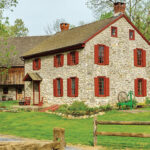










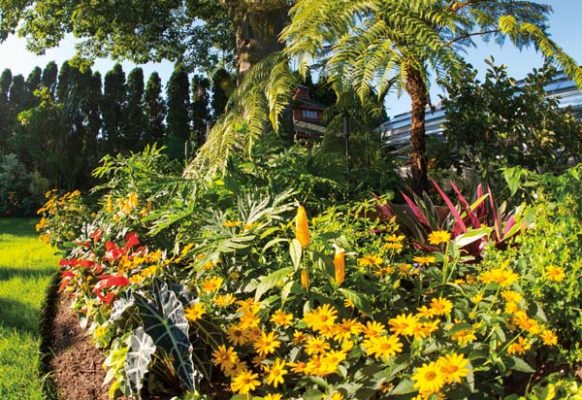









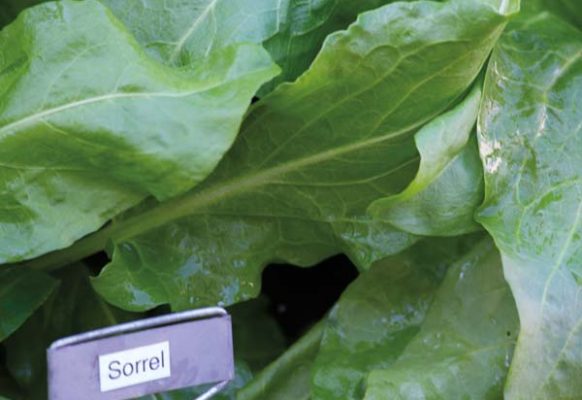


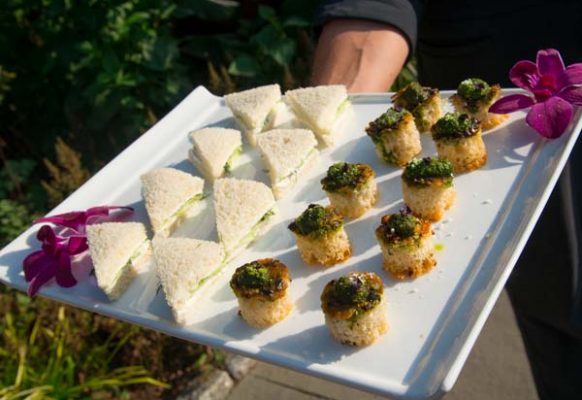




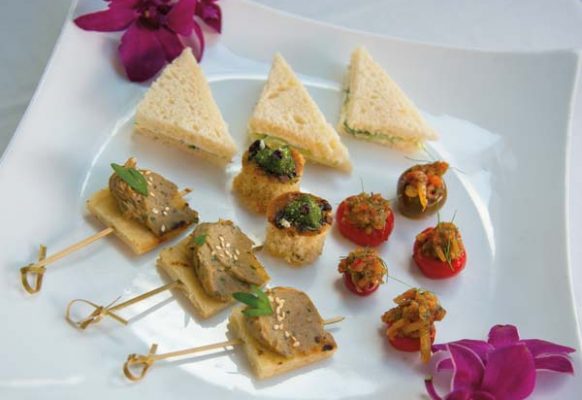







SHARE
PRINT